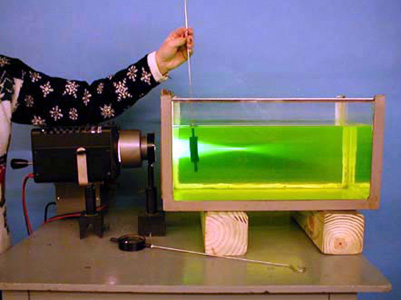Demos: 7A-31 Effect on Medium on Lens Action

A sealed, double convex “air lens” can be kept immersed in an aquarium containing water. This lens will diverge a parallel beam of light. Similarly, a double concave lens will converge a parallel beam.
Directions: Lower the lens into the water and turn on the projector lamp. Direct the beam through the lens. The path of the beam will show in the fluorescene dyed water.
Suggestions for Presentation: Students often are locked into the shape of a lens as defining what will happen to the light passing through it. Indeed, most, if not all, ray diagrams in texts assume air as the external medium and some higher index of refraction for the lens. In such cases the double convex lens always converges a parallel beam, whereas a double concave lens diverges the beam. Show the students the lens shape and ask what will happen to a parallel beam as it passes through the lens. Most will predict a result based on the usual air to glass sequence. After immersing the lens in water and seeing that does the opposite, discuss the assumed conditions in normal ray diagrams and focus on how this situation is different.
Applications: A rather famous photograph from NASA shows astronaut Shannon Lucid in an immersion tank, working in a simulated weightless environment. She is wearing a space helmet and her head looks dramatically smaller than would be expected. The air in her helmet produced an air lens that diverged rather than converged the rays.
Last Updated: Nov 30, 2023 11:25 AM